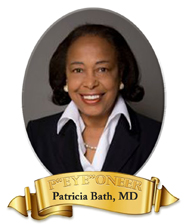
So Many Firsts: Patricia Bath, MD
Patricia Bath was born in Harlem in 1942. Her father, Rupert Bath, was an immigrant from the island of Trinidad. Her mother, Gladys Bath, was an American citizen, whose direct descendants were African slaves and Cherokee Indians. Patricia’s father was a community activist and a columnist for the Harlem-based, African American owned Amsterdam News, and her mother worked as a domestic. “Although we did not have much, by their examples, I was inspired by my parents’ diligence,” Dr. Bath proudly stated. “Both of my parents encouraged my early love for books and medicine.”
After excelling in her studies in high school and university and earning awards for scientific research as early as age sixteen, Dr. Bath embarked on a career in medicine. She received her medical degree from Howard University College of Medicine, interned at Harlem Hospital from 1968 to 1969, and completed a fellowship in ophthalmology at Columbia University from 1969 to 1970. Following her internship, Dr. Bath completed her training at New York University between 1970 and 1973, where she was the first African American resident in ophthalmology. Bath married and had a daughter. While motherhood became her priority, she also managed to complete a fellowship in corneal transplantation and keratoprosthesis (replacing the human cornea with an artificial one). In 1975, she was the first woman ophthalmologist to be appointed to the faculty of the UCLA School of Medicine Jules Stein Eye Institute. From 1983 to 1986, Bath was the first woman chair and first female program director of a postgraduate training program in the United States (at UCLA).
As a young intern shuttling between Harlem Hospital and Columbia University, Bath observed that at the eye clinic in Harlem half the patients were blind or visually impaired. At the eye clinic at Columbia, by contrast, there were very few blind patients. This observation led her to conduct an epidemiological study, which documented that blindness among blacks was double that among whites. She reached the conclusion that the high prevalence of blindness among blacks was due to lack of access of ophthalmic care. As a result, she proposed a new discipline, known as community ophthalmology. Community ophthalmology combines aspects of public health, community medicine, and clinical ophthalmology to offer primary care to underserved populations. Volunteers trained as eye workers visit senior centers and daycare programs to test vision and screen for cataracts, glaucoma, and other threatening eye conditions. This outreach has saved the sight of thousands whose problems would otherwise have gone undiagnosed and untreated. By identifying children who need eyeglasses, the volunteers give these children a better chance for success in school.
In 1977, she and three other colleagues founded the American Institute for the Prevention of Blindness. The mission of the AIPB is the prevention and cure of blindness among all races and creeds. Much of the work of the AIPB is done though ophthalmic assistants, who are trained in programs at major universities. The institute supports global initiatives to provide newborn infants with protective anti-infection eye drops, to ensure that children who are malnourished receive vitamin A supplements essential for vision, and to vaccinate children against diseases (such as measles) that can lead to blindness.
Dr. Bath is also a laser scientist and inventor. Her interest, experience, and research on cataracts lead to her invention of a new device and method to remove cataracts—the laserphaco probe. When she first conceived of the device in 1981, her idea was more advanced than the technology available at the time. It took her nearly five years to complete the research and testing needed to make it work and apply for a patent. Consequently, she became the first African American female doctor to receive a patent for a medical invention (#4,744,360). With the keratoprosthesis device, Dr. Bath was able to recover the sight of several individuals who had been blind for over 30 years.
*****
Sources:
NIH.gov, HistoryMakers and Missouri.edu
Have a thought about this article? Contact Us and let us know.